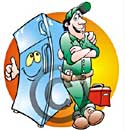Home > AIR CONDITIONING HEATING AND
Maytag Appliance REPAR
If you need San Antonio, TX repair on your heating systems,
we can come to your home any time that it is convenient for you.
Call us 24/7 at our toll free number:
210 538-9875
Or send an appointment request online at appointment@maytagrepairsanantonio.com
To do so, please specify your name, address and a brief nature of
the problem. Once we receive your request we will contact you as
soon as possible.
San Antonio
Hondo
New Braunfels
Canyon Lake
Live Oak Helotes
Castroville
Marion
Floresville
Spring Branch
|
Cibolo
Fair Oaks Ranch
Adkins
Helotes
La Vernia
Pipe Creek
Boerne
Bandera
Devine
|
Schertz
Live Oak
Bulverde
Converse
Seguin
Pearsall
Jourdanton
Pleasanton
Fischer
|
The products we fix in San Antonio, TX include: heating repair, replacement,
installation. We service all San Antonio, TX County -- check the list
of areas we service.
We work on the following brands: Ducane heating sustems, Trane
heating sustems, American Standard heating sustems, Goodman heating
sustems, Carrier heating sustems, Bryant heating sustems, Payne
heating sustems, GE heating sustems, Janitrol heating sustems, Aprilaire
heating sustems, Fedders heating sustems, Lennox heating sustems,
Luxaire heating sustems, Comfortmaker heating sustems, Tempstar
heating sustems, Amana heating sustems, York heating sustems, Rheem
heating sustems, Ruud heating sustems, Armstrong heating sustems,
Heil heating sustems, and many other
brands of heating systems.
Below we have provided preventative and easy-to-repair
tips for your heating systems. If your issue cannot be resolved
with our easy tips, we strongly suggest that you call us for an
appointment. We will be happy to help.
Direct heat and central heat
Some 22 million American homes have a direct- heating sustems a
throwback to the era of fire places and potbellied stoves. The heating
apparatus exudes warmth directly to the space where heating system
is located. Electricity provides a particularly comfortable source
of direct heating. Resistance wires, similar in principle to the
elements in a toaster, run through baseboard heating units or may
be strung inside walls, ceilings or floors; individual heating thermostats
control the temperature in each room.
The great majority of homes, however, have central- heating systems.
These heating systems are popular largely because they are more
efficient and can be located in an out-of-the-way place, yet can
heat the entire house. Central heating systems are made up of several
distinct units:
HEAT PRODUCER. This may be an oil, gas or wood
burner, an electric heater or a heat pump, alone or in combination.
HEAT EXCHANGER. This unit is called a furnace if
it heats air, a boiler if it heats water or makes steam. The air,
water or steam goes through passageways inside the exchanger that
keep it separated from the combustion gases of the burner; the gases
are expelled through a flue. Any of these heat exchangers can be
hooked up to any of the several kinds of heat producers.
HEAT DISTRIBUTOR. There are three types, one for
each type of exchanger. In a warm-air system, the air is drawn into
the exchanger by a large fan (a blower) and sent through ducts to
warm-air registers. In a hot-water system, water is forced through
the exchanger by a pump (a circulator) and sent through pipes to
convectors, a type of radiator. Steam rises under its own pressure
from the exchanger, going through pipes to radiators.
CONTROLS. Most homes have one thermostat in, the
living area to turn the heating plant on and off. But some achieve
closer control with several, and a few installations sense out side
temperature in order to respond more to weather changes.
The most common problem with central sustains is uneven heat: rooms
nearest the heat producer get too hot, those farther away never
get warm enough. Since tinkering with one part of a system may affect
other parts, adjustments may take days or weeks; so this is primarily
a job for the homeowner.
Steam systems are least amenable to adjustment, but the heat of
individual radiators can be regulated by turning the dial on each
air vent (page 323). If your vents are not adjustable, change them;
they are not expensive.
If your issue cannot be resolved with our easy tips, we
strongly suggest that you call us for an appointment.
210 538-9875
Or send an appointment request online at appointment@maytagrepairsanantonio.com
To do so, please specify your name, address and a brief nature of
the problem. Once we receive your request we will contact you as
soon as possible. We will be happy to help.
|

